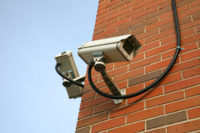 Parents take a double leap of faith every day when they turn their children over to the nation's public and private schools. They believe that a good education will enable children to function more successfully in the world, and they believe that their children will be safe and protected throughout the day.
Parents take a double leap of faith every day when they turn their children over to the nation's public and private schools. They believe that a good education will enable children to function more successfully in the world, and they believe that their children will be safe and protected throughout the day.
However, with the overall greater focus on school security accelerated by a number of tragic headlines in the past few years, parents are looking to school districts for assurance that appropriate steps are being taken to keep children safe. One well-established and proven tool to enable educators and administrators to provide safer learning environments is video surveillance, viewed and managed via a robust video management system.
Video management systems (VMS) are a central component of surveillance that maximize the ability of video cameras located throughout an education campus to keep students and facilities safe. Here are five ways an effective VMS can facilitate management of video surveillance to ensure a safer school:
1. Watching student activity.Video cameras provide school administrators extra sets of eyes to watch what's happening all over the campus. Thanks to video management software, simple-to-use access to those camera views is as close as the nearest computer, or they can even be viewed on hand-held devices such as smartphones. Multiple users can view the same camera, or one user can “push” video to another user to call attention to a situation. With concerns such as loss prevention or vandalism, the ability of administrators to closely monitor student activity and respond appropriately is more valuable than ever.
2. Monitoring building access. Keeping students safe requires total control of who comes and goes on a campus. Video management software unifies the camera views throughout a campus and makes it easy for administrators to manage those views to monitor entrances and exits. When integrated with an access control system, video can be pushed to a monitor whenever someone is denied access to the building. Schools should also control access to rooms and keep an eye on hallways and cafeterias – video enables them to do just that.
3. Providing after-hours surveillance. Sometimes schools are used by outside organizations after school hours, and video surveillance can help to monitor those activities. When schools are closed for the night, video motion detection can provide an alarm if something moves in an empty hallway, for example, and video software can provide immediate views of cameras in the vicinity. Used as a forensic tool, video surveillance software can make it easy for administrators to determine the source of weekend vandalism or to solve a break-in or theft.
4. Aiding first responders in case of an emergency. When a school emergency happens, it is absolutely critical that first responders know immediately what is happening so they can respond appropriately. IP video management systems enable access to a school's cameras remotely from a handheld device or a laptop computer in a police car. Such access aids swift response to school violence by enabling police responders to know immediately the conditions inside the school and the location of the perpetrator and possible victims before entering the premises. They can then adapt their response accordingly. In case of a severe emergency, the school's central office can monitor evacuation response remotely.
5. Saving resources that could be used elsewhere. The recent economic downturn has been a challenge for many school districts with dwindling tax money creating budget shortfalls that often require tough economic choices. Student safety is obviously the last thing anyone would want to compromise to save costs. Fortunately, the cost of video management software is reasonable, and significant discounts for schools, universities and other educational institutions often make it even more so. Ensuring the affordability of this important component of school safety enables school districts to prioritize security while minimizing the investment and avoiding more severe economic cuts in other parts of the budget.
Views from cameras located throughout a school can provide important everyday safety information, presented in a usable format thanks to video management software. Video surveillance can ensure school discipline policies are firmly and fairly enforced and provide live views of possible trouble spots on campus. Surveillance can also protect school property from theft and vandalism, during the school day and after hours, inside and outside school buildings. In the unlikely event of school violence or other tragedy, cameras directed by video management software can provide eyes inside the building to guide a more effective, and safer, response.



